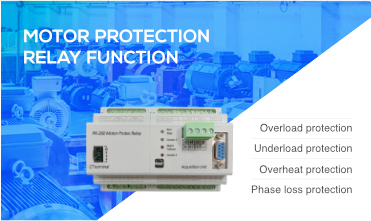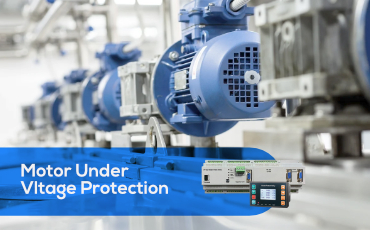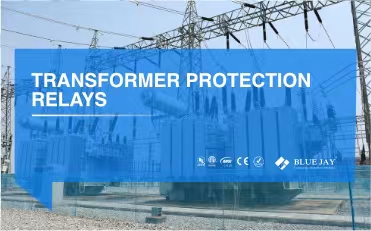
What are the transformer protection relays?
By bluejay | Company News
Transformer protection relays are essential devices that safeguard power transformers from various electrical faults and abnormal operating conditions. These relays are designed to detect and isolate faults quickly, preventing damage to the transformer and ensuring the stability of the power system. As for transformer protection relays, Blue Jay can offer partial discharge monitoring relays, transformer temperature controllers, dehumidifiers for transformers, etc.
Blue Jay Transformer protection relay types
According to the different types of transformer faults, there are different types of transformer protection relays. This part will introduce the transformer protection relay types based on Blue Jay transformer protection relays.
Blue Jay Partial Discharge (PD) Monitoring Relays
Blue Jay PD3000 is used to monitor partial discharge inside the transformer and detect insulation defects in time. It employs a multi-modal detection architecture combining:
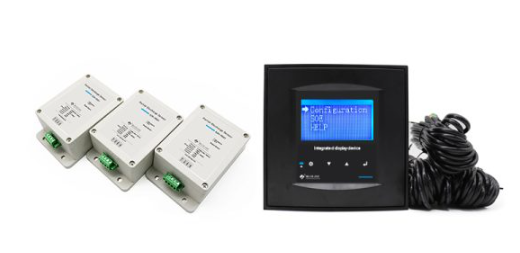
- Ultra-high frequency (UHF) sensors (300MHz-3GHz) with 0.5pC sensitivity
- Transient Earth Voltage (TEV) sensors for surface discharge detection
- High-frequency current transformers (HFCT) with 50MHz bandwidth
The system implements phase-resolved partial discharge analysis (PRPDA) using 16-bit ADCs sampling at 100MS/s, enabling real-time tracking of discharge patterns through:
- φ-Q-N (phase-charge-number) matrix mapping
- Pulse sequence analysis for identifying cavity discharges
- Statistical operators (skewness, kurtosis) for corona discrimination
Blue Jay TWSK Series Transformer Temperature Controller
Blue Jay TWSK Transformer Temperature Controller is designed to monitor the temperature inside the transformer in real time, usually by collecting data through temperature sensors installed in key locations such as transformer windings or oil chambers.
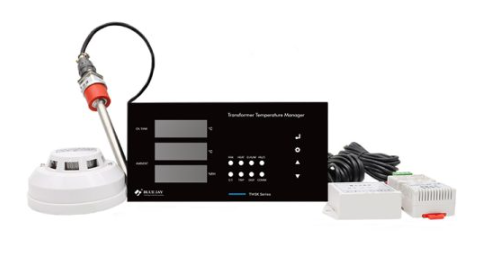
The temperature signal collected by the sensor is transmitted to the relay control unit and compared with the preset temperature threshold. Once the temperature exceeds the set safety threshold, the relay will initiate protection measures through a preset response mechanism.
Main functions of TWSK
- Temperature Monitoring: The relay uses high-precision sensors to continuously track transformer temperature, adjusting measurements based on real-time load and environmental factors to ensure accurate data.
- Temperature Alarm and Protection: The relay compares temperature with set thresholds. If exceeded, it triggers alarms, activates cooling systems, or disconnects power to prevent further damage.
- Remote Monitoring and Data Transmission: Modern relays integrate with remote systems, transmitting real-time temperature data via protocols like Modbus. Operators can monitor and adjust settings remotely to respond to faults.
Blue Jay DH Series Industrial Dehumidifier
Moisture accumulation in transformers, particularly in insulating oil, reduces dielectric strength and increases failure risks. High humidity can degrade insulation, corrode metal components, and cause short circuits, compromising transformer reliability.
Blue Jay transformer dehumidifier integrates with humidity sensors to continuously monitor moisture levels inside and around the transformer. When humidity exceeds the preset threshold, the relay activates dehumidification units to extract excess moisture, preventing insulation deterioration.

Key Features
- Real-time Humidity Monitoring: High-precision sensors detect variations in moisture content.
- Automatic Dehumidifier Control: The relay triggers drying systems to maintain optimal conditions.
- Integration with Protection Systems: Can be linked to remote monitoring via Modbus for predictive maintenance.
Application of transformer protection relays
Transformer protection relays have a wide range of applications in power systems, safeguarding transformers from various faults and abnormal operating conditions. Here are some key applications:
- Power Transformers in Substations
Protection relays are crucial for protecting power transformers in substations, which are essential for transmitting and distributing electricity.
- Generator Transformers
In power plants, generator transformers step up the voltage from the generator level to the transmission level. Transformer protection relays are used to safeguard these transformers from faults that can occur during power generation.
- Industrial Applications
Industries with large electrical loads, such as manufacturing plants and refineries, use transformers to supply power to their equipment.
Protection relays are essential to protect these transformers from faults that can disrupt production processes.
- Distribution Transformers
Distribution transformers, located closer to consumers, reduce the voltage to a level suitable for homes and businesses. Transformer Protection relays are used to protect these transformers from faults that can affect the quality of the power supply.
- Special Applications
Protection relays are also used in special applications like:
Traction substations: To protect transformers supplying power to electric trains.
Renewable energy systems: To protect transformers in wind farms and solar power plants.
Offshore platforms: To protect transformers in harsh marine environments.
Conclusion
Transformer protection relays are vital for ensuring reliable operation and preventing failures. Blue Jay advanced relays mitigate key risks such as partial discharge, overheating, and moisture buildup. With high reliability and seamless integration, they help utilities and industries enhance transformer safety, reduce downtime, and maintain a stable power grid.
Related articles
Tags
Company News
Transformer protection relays are essential devices that safeguard power transformers from various electrical faults and abnormal operating conditions. These relays are designed to detect and isolate faults quickly, preventing damage to the transformer and ensuring the stability of the power system. As for transformer protection relays, Blue Jay can offer partial discharge monitoring relays, transformer temperature controllers, dehumidifiers for transformers, etc.
Blue Jay Transformer protection relay types
According to the different types of transformer faults, there are different types of transformer protection relays. This part will introduce the transformer protection relay types based on Blue Jay transformer protection relays.
Blue Jay Partial Discharge (PD) Monitoring Relays
Blue Jay PD3000 is used to monitor partial discharge inside the transformer and detect insulation defects in time. It employs a multi-modal detection architecture combining:

- Ultra-high frequency (UHF) sensors (300MHz-3GHz) with 0.5pC sensitivity
- Transient Earth Voltage (TEV) sensors for surface discharge detection
- High-frequency current transformers (HFCT) with 50MHz bandwidth
The system implements phase-resolved partial discharge analysis (PRPDA) using 16-bit ADCs sampling at 100MS/s, enabling real-time tracking of discharge patterns through:
- φ-Q-N (phase-charge-number) matrix mapping
- Pulse sequence analysis for identifying cavity discharges
- Statistical operators (skewness, kurtosis) for corona discrimination
Blue Jay TWSK Series Transformer Temperature Controller
Blue Jay TWSK Transformer Temperature Controller is designed to monitor the temperature inside the transformer in real time, usually by collecting data through temperature sensors installed in key locations such as transformer windings or oil chambers.

The temperature signal collected by the sensor is transmitted to the relay control unit and compared with the preset temperature threshold. Once the temperature exceeds the set safety threshold, the relay will initiate protection measures through a preset response mechanism.
Main functions of TWSK
- Temperature Monitoring: The relay uses high-precision sensors to continuously track transformer temperature, adjusting measurements based on real-time load and environmental factors to ensure accurate data.
- Temperature Alarm and Protection: The relay compares temperature with set thresholds. If exceeded, it triggers alarms, activates cooling systems, or disconnects power to prevent further damage.
- Remote Monitoring and Data Transmission: Modern relays integrate with remote systems, transmitting real-time temperature data via protocols like Modbus. Operators can monitor and adjust settings remotely to respond to faults.
Blue Jay DH Series Industrial Dehumidifier
Moisture accumulation in transformers, particularly in insulating oil, reduces dielectric strength and increases failure risks. High humidity can degrade insulation, corrode metal components, and cause short circuits, compromising transformer reliability.
Blue Jay transformer dehumidifier integrates with humidity sensors to continuously monitor moisture levels inside and around the transformer. When humidity exceeds the preset threshold, the relay activates dehumidification units to extract excess moisture, preventing insulation deterioration.

Key Features
- Real-time Humidity Monitoring: High-precision sensors detect variations in moisture content.
- Automatic Dehumidifier Control: The relay triggers drying systems to maintain optimal conditions.
- Integration with Protection Systems: Can be linked to remote monitoring via Modbus for predictive maintenance.
Application of transformer protection relays
Transformer protection relays have a wide range of applications in power systems, safeguarding transformers from various faults and abnormal operating conditions. Here are some key applications:
- Power Transformers in Substations
Protection relays are crucial for protecting power transformers in substations, which are essential for transmitting and distributing electricity.
- Generator Transformers
In power plants, generator transformers step up the voltage from the generator level to the transmission level. Transformer protection relays are used to safeguard these transformers from faults that can occur during power generation.
- Industrial Applications
Industries with large electrical loads, such as manufacturing plants and refineries, use transformers to supply power to their equipment.
Protection relays are essential to protect these transformers from faults that can disrupt production processes.
- Distribution Transformers
Distribution transformers, located closer to consumers, reduce the voltage to a level suitable for homes and businesses. Transformer Protection relays are used to protect these transformers from faults that can affect the quality of the power supply.
- Special Applications
Protection relays are also used in special applications like:
Traction substations: To protect transformers supplying power to electric trains.
Renewable energy systems: To protect transformers in wind farms and solar power plants.
Offshore platforms: To protect transformers in harsh marine environments.
Conclusion
Transformer protection relays are vital for ensuring reliable operation and preventing failures. Blue Jay advanced relays mitigate key risks such as partial discharge, overheating, and moisture buildup. With high reliability and seamless integration, they help utilities and industries enhance transformer safety, reduce downtime, and maintain a stable power grid.
Related articles


